 By STLE
By STLE
The Society of Tribologists and Lubrication Engineers (STLE) recently released their 2017 Report on Emerging Issues and Trends in Tribology and Lubrication Engineering. The report builds on industry research first conducted in 2014. Research included approximately 15 interviews with industry experts to identify new areas to investigate or trends to further explore, followed by a literature review of recent industry publications, conference abstracts and other materials.
A survey launched in April 2017 collected more than 900 respondents from professionals across the tribology field; data were shared with about 30 industry experts to provide context and narrative to the quantitative findings. Key findings were divided among several categories that fall under two key headings: Field Discipline Areas and Field Issues.
Field discipline areas:
- Transportation: Seventy percent of survey respondents saw pure-electric vehicles as a significant long-term trend, followed by self-driving, autonomous vehicles (68%) and high-efficiency vehicles (59%). Tribology is expected to play a significant role in future advancements as society looks for greater fuel economy and reduced emissions.
- Medical/Health: An aging population and a growing demand for artificial joints have created increased demand for tribology-based solutions in health care. Survey respondents saw the greater usage of prosthetics (59%) and greater expectations for mobility (56%) as key long-term trends. These trends point to great opportunity in the area of bio-tribology as well.
- Energy: Survey respondents viewed the decreased use of fossil fuels (62%) and a corresponding interest in renewable energy sources – including solar (58%) and wind (49%) – as key long-term trends. These trends can be driven by political, social and economic factors.
- Manufacturing: A focus on automation (59%) and recycling (57%) are indicators of the pressure manufacturers are under to increase productivity and efficiency. The ability to monitor machines could lead to less down time, better reliability, and increased output.
- Communications and Data Management: A reduction in the physical computing infrastructure has reduced the need for tribological advancements in this area, but the Internet of Things (IoT) and sensor-based monitoring has opened up opportunities for lubricant suppliers to leverage data to help improve a machine’s longevity. Survey respondents overwhelmingly saw continuous monitoring of lubricants and moving parts as the top trend in this area (61%).
- Atomistic Processes: Understanding nano-scale systems and applying that knowledge to larger-scale systems is the most significant long-term trend in this area (67%). A continued focus on atomistic processes underscores the growing complexity and sophistication of tribology as well, industry experts said.
Field Issues:
- Outlook on the Field: The ability to attract talent (62% of survey respondents said this was a major challenge for the field) remains a key concern for tribologists and lubrication engineers, especially as systems and challenges become more complex. Tribology’s role in reducing the environmental footprint of the manufacturing, transportation and energy sectors in particular was also a key ongoing trend for survey participants.
- Government Regulation: Industry experts remarked how government regulation can either spur innovation and act as a catalyst for development, or it can add challenges because of inconsistent laws and varying requirements. Industrial waste regulations (57%) and water pollution restrictions (55%) were seen as the regulatory areas most likely to have an impact on the tribology field.
- Safety and the Environment: Along the same lines, survey participants identified occupational health and environmental concerns as key issues moving forward, and cited automation as an important development with strong worker safety implications. Biodegradability was specifically cited as a key long-term industry trend for more than half of survey respondents.
- Basic Human Needs: Growing demands for food and water around the world have created new challenges for tribologists. Survey respondents were focused mostly on the production of sustainable energy and the reduction of waste, which can have a positive downstream impact on key fundamental issues, such as food production and clean, safe water.
FOR MORE INFORMATION:
The full 2017 Report on Emerging Issues and Trends in Tribology and Lubrication Engineering may be accessed on STLE’s website, at http://www.stle.org. If you need additional information, please contact Nadine Sanchez at nadine@stle.org or call 847-825-5536 (US).
About STLE
![]() The Society of Tribologists & Lubrication Engineers (STLE) is the premier technical society serving the needs of over 12,000 individuals and 250 companies and organizations that comprise the tribology and lubrication engineering business sector. STLE members are employed by the world’s leading corporations, academic institutions and by governmental agencies dealing with science and technology. STLE supports these distinguished technical experts with a variety of professional education and certification programs.
The Society of Tribologists & Lubrication Engineers (STLE) is the premier technical society serving the needs of over 12,000 individuals and 250 companies and organizations that comprise the tribology and lubrication engineering business sector. STLE members are employed by the world’s leading corporations, academic institutions and by governmental agencies dealing with science and technology. STLE supports these distinguished technical experts with a variety of professional education and certification programs.
The views, opinions and technical analyses presented here are those of the author or advertiser, and are not necessarily those of ULProspector.com or UL Solutions. The appearance of this content in the UL Prospector Knowledge Center does not constitute an endorsement by UL Solutions or its affiliates.
All content is subject to copyright and may not be reproduced without prior authorization from UL Solutions or the content author.
The content has been made available for informational and educational purposes only. While the editors of this site may verify the accuracy of its content from time to time, we assume no responsibility for errors made by the author, editorial staff or any other contributor.
UL Solutions does not make any representations or warranties with respect to the accuracy, applicability, fitness or completeness of the content. UL Solutions does not warrant the performance, effectiveness or applicability of sites listed or linked to in any content.


